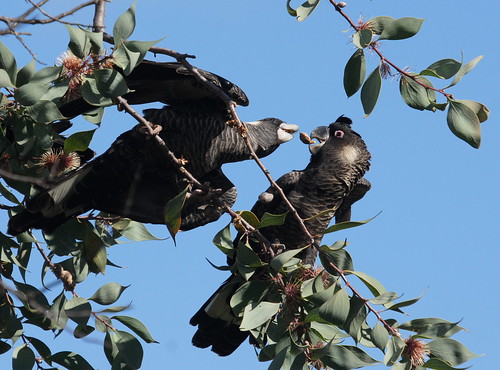 All three species are being used in research; Baudin’s black cockatoos, Forest Red-Tailed black cockatoos and (pictured) Carnaby’s black cockatoos. Image: Ron & BethWESTERN Australian research groups and conservationists are continuing to work together in the fight to conserve the Carnaby’s black cockatoo (Calyptorhynchus latirostris) which has long been recognised as the Swan Coastal Plain’s most iconic bird, once blackening Perth skies with countless flock sizes – now seriously endangered.
All three species are being used in research; Baudin’s black cockatoos, Forest Red-Tailed black cockatoos and (pictured) Carnaby’s black cockatoos. Image: Ron & BethWESTERN Australian research groups and conservationists are continuing to work together in the fight to conserve the Carnaby’s black cockatoo (Calyptorhynchus latirostris) which has long been recognised as the Swan Coastal Plain’s most iconic bird, once blackening Perth skies with countless flock sizes – now seriously endangered.
At the centre of conservation efforts is Kaarakin Black Cockatoo Conservation Centre – the main reserve where black cockatoos are rehabilitated, bred and released back into the State.
Department of Environment and Conservation (DEC), Murdoch University, Perth Zoo and a wealth of other research and bird community groups work through Kaarakin in research and conservation roles, with recent projects involving the release of ‘tracked’ Carnaby’s to monitor their flight and habitat patterns.
A Murdoch University and Perth Zoo project recently used rehabilitated cockatoos housed at Kaarakin to trial different radio and satellite transmitter attachments to solve problems associated with devices used to track cockatoos.
All three species are being used in research; Carnaby’s, Baudin’s black cockatoos (Calyptorhynchus baudinii) and Forest Red-Tailed black cockatoos (Calyptorhynchus banksii).
“This is the fifth release of cockatoos from Kaarakin,” says Kaarakin CEO, Phil Digney.
He adds all Carnaby’s are released with transmitters.
Last year a flock of Carnaby’s attached with transmitters and colourful tail markings were released from Kaarakin in support of PhD candidate Christine Groom’s research.
Another area key to cockatoo conservation; habitat, is being tackled by DEC, who are regenerating nearly 100 acres of old orchard adjacent to Kaarakin.
Kaarakin and DEC are working in partnership with Carbon Neutral’s Urban Forest concept on ecosystem restoration.
“We’ll revegetate with long term black cockatoo food, nesting and roosting plant species in mind,” says Mr Digney.
Kaarakin’s rehabilitation and breed-for-release programs involve a purpose built extra long flight aviary for birds to strengthen their flight muscles.
Flight strength is stringently tested by flying the birds up and down the aviary, simulating the flight strength of wild birds.
The cockatoos are then vet-cleared and released into designated DEC sites.
Lottery West funding is enabling new infrastructure at Kaarakin including an upgrade on their dome exhibit allowing visitors to see wild cockatoos from an elevated boardwalk.
Meanwhile results from DEC and Birdlife Australia’s Great Cocky Count will soon be available and eagerly awaited by Kaarakin and other cockatoo conservation groups.
The annual survey provides evidence of Carnaby’s black cockatoo numbers and its statistics are largely responsible for alerting WA to the drastically declining population of the species (over 50 per cent).
“This information on population trends is important so we can better manage the species in the future,” says Mr Digney.